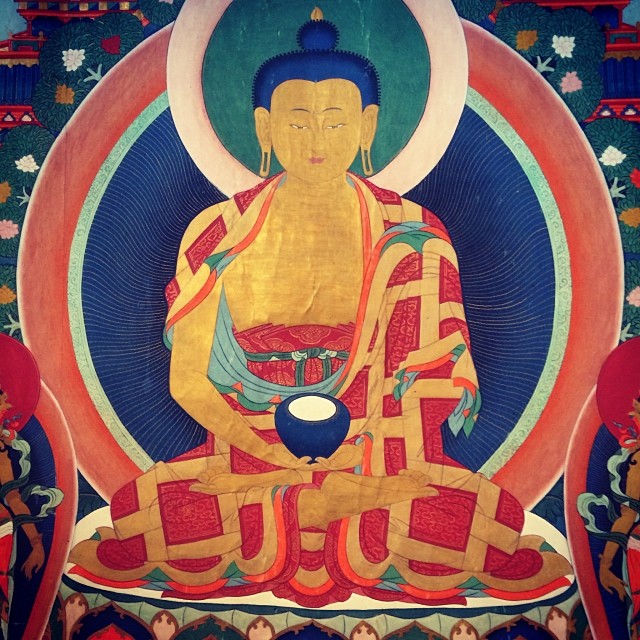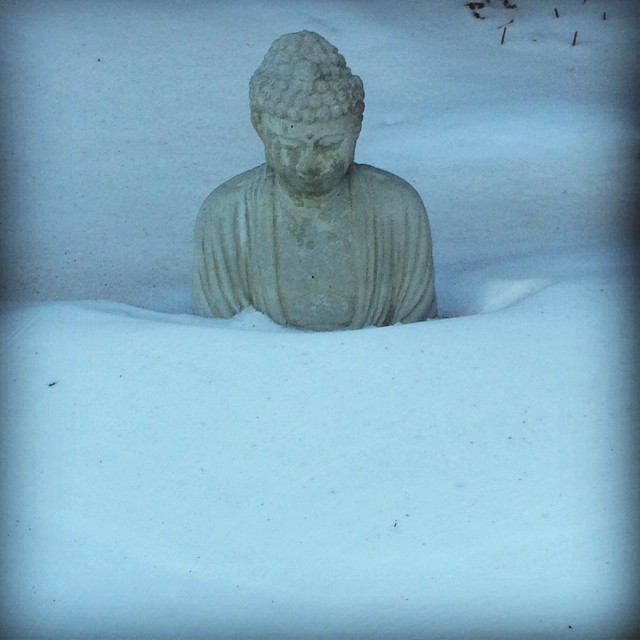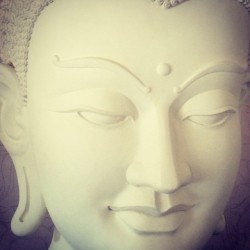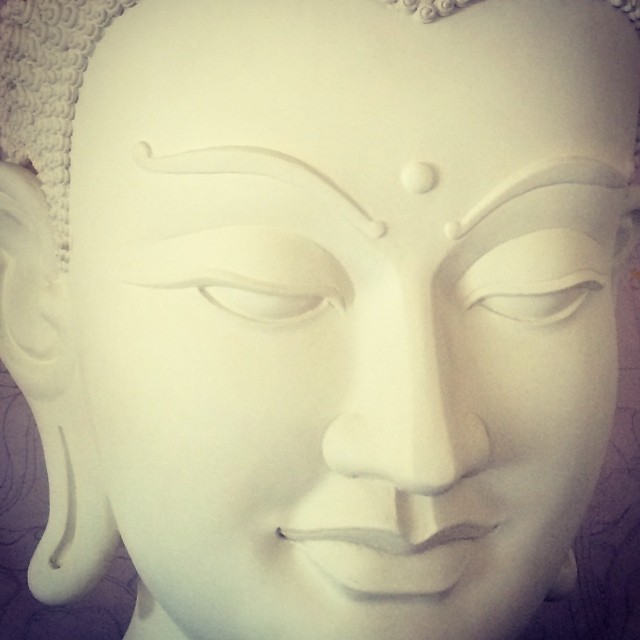Let’s talk about New Year’s Resolutions.
If that seems like an old subject—well, that’s the problem with conventional Resolutions. We might think about what we want to change in our lives in the end of December, and on January 1st…
…and then the rush of life resumes, and all that thought about change and the passing of time seems like…
…well, old news.
So let’s take a small step back, now, before that rush of our life pushes us ever further downstream. Let’s actually give ourselves the time to engage in these four simple timeless “Resolutions,” from the Buddha.
How to get your New Year’s Resolution to be meaningful—and to survive.
Ready to fall in love with your life? Join our self-paced Maitri: How to Fall in Love with your Sweet Self with modest discount, for the New Year.
New Year’s Resolutions do not succeed through Willpower, but through Gap.
I did a video talk, this morning, with crazy bedhead, about a Buddhist approach to the New Year. It’s important, I feel, in this busy-hasty world, to appreciate these opportunities to mark the passage of time, that is the fuel of this precious short life of ours.
If you need help feeling inspired and personally mindful for the new year, you may get something out of it:
How you and Elephant can be of huge benefit in the New Year to a wonderful but crazy world in need.
New Year’s resolutions are often practical: lose some weight, start reading more, start running, finish that book.
What they miss is the motivation that will get us through times of inspiration and lack of inspiration.
Motivation does not come from willpower.
Willpower breaks, falters in the warm trance of the present moment “maybe I’ll just eat that entire cake.”
True, foundational motivation comes from empathy, from appreciation, and from the feeling that we can be of benefit.
Good news: we can cultivate those three things through our morning and evening meditation.
Now there’s your New Year’s Resolution.
Meditate, for a few minutes each morning. Begin with a bow, and dedicate your day to be of benefit. Then, good posture, place attention on breath in and out. Eyes open (especially in the morning) as we don’t want to separate ourselves from our lives, but to infuse our daily life with the power of this simple (straightforward) yet difficult (lifelong) meditation. End with a contemplation: “What is one thing I feel compassion about?” And, “What is one thing I’m grateful for?” You’ve already started with the aspiration to be of benefit. Bow out.
~
A Merry New Year’s to all of you, dear Elephant readers, dear good humans, dear you. In many ways it’s been a long, dark, rancorous year. But as Pema Chodron often reminds us, this is a time that reminds us of what is precious. Crisis is opportunity. The way out of our problems is not selfishness, but caring. Empathy will show us our path forward. Empathy will show us our path forward. Remember that, and your New Year will be a full, sweet, love-ful one.

All photos: @waylonlewis on Instagram, taken at Shambhala Mountain Center. I’m up here at Taking the Leap into 2014, a New Year’s Retreat led by Jon Barbieri. Meditation, hikes to the Stupa, banquet, waltzing, movie, meditation, meditation, lectures, meditation, aspirations and good-riddances. It’s been fun and fulfilling, both.
The Buddha’s Four New Year’s Resolutions.
Okay, traditionally they’re referred to as the Four Limitless Qualities, or Prayers.
Society says we’re not good enough, rich enough, thin enough. But what if we reversed the usual New Year’s Resolution trap, and did something that worked?
Most New Year’s resolutions are predicated on not being happy enough, or not having what we want, or needing to be prettier, or thinner, or more organized.
So what if we began with accepting ourselves with maitri, or loving-kindness, and extended that genuine happiness outward?

Original article follows.
The Buddha offered four limitless qualities worth cultivating. The first contemplation:
May all sentient beings enjoy happiness and the root of happiness
Recite these to yourself, each for a few minutes. Then discuss with a friend or friends or colleagues, if you’ve done this contemplation in a group setting.
First, recite “May I enjoy happiness and the root of happiness…”
Then, recite “May my loved one [name, could be your mom or dad] enjoy happiness and the root of happiness…”
Then, recite “May my best friends [can be many names] enjoy happiness and the root of happiness…”
Then, recite “May [those you feel indifferent toward] enjoy happiness and the root of happiness…”
Then, recite “May [my ‘enemy’, name] enjoy happiness and the root of happiness”
Then, recite “May all sentient beings enjoy happiness and the root of happiness.”
That all sounds nice, right? But just you wait: this is hard stuff.
Reciting these four contemplations is like exercising a new muscle, usually. Wishing ourselves happiness? Some of us have a hard time with that. We don’t deserve it, we aren’t worthy, we shouldn’t go first, we should hide our light under a bushel. That one’s easy for me: it helps me refine and define what I mean by happiness and the root of happiness.
 For happiness is something—in the West at least—that’s sold to us, pushed on us, hyped at us…and it rarely results in happiness.
For happiness is something—in the West at least—that’s sold to us, pushed on us, hyped at us…and it rarely results in happiness.
We can’t make ourselves happy via external products, weight loss, love.
Happiness is more fundamental that that.
Chogyam Trungpa, the Buddhist meditation master, urged us not to wish one another Happy Birthday, but rather Cheerful Birthday—for happiness is a conditional state of mind, as opposed to the fundamental state of being that contentment or cheerfulness or being at ease implies. And conditional states of mind—happy, sad, good, bad, in love, broken-hearted—are suffering, the cyclical state of pushing away and clinging to that is called “samsara.”
So, we don’t wish conditional happiness on ourselves or others. We wish fundamental happiness, the roots of happiness.
And we wish it not only to ourselves, our loved ones, our best friends…but to those we take for granted, or feel indifferent or neutral toward. The baristas or waiters or mailwomen or those who we don’t know well, or feel strongly about.
And we wish it to our “enemies”—to those who challenge us, who upset us, who mistreat us. We wish them fundamental happiness, and as the saying goes, only love can make our enemies into friends. And even if that’s not our goal—some challenging people don’t belong in our lives—we can change our own attitude from confusion to kindness.
And we wish it, finally, to all sentient beings—tigers, blades of grass, mice, dogs, cats, birds, all humans everywhere—those who make those products that capitalism is hyping at us…everyone.
And in so doing, this prayer doesn’t change anything—except ourselves.
And in changing ourselves, en masse, we change our society, and world.
The Four Reminders are something we Buddhists repeat, and remind ourselves of, every day. But there’s nothing patently “Buddhist” about them—we’re basically just remembering that life is vulnerable, fragile, precious, and shouldn’t be wasted doing stupid, selfish, insincere stuff.
Four Reminders
Joyful to have
Such a human birth,
Difficult to find,
Free and well-favored.But death is real,
Comes without warning.
This body
Will be a corpse.Unalterable
Are the laws of karma;
Cause and effect
Cannot be escaped.Samsara
Is an ocean of suffering,
Unendurable,
Unbearably intense.Composed by the Vidyadhara Chögyam Trungpa Rinpoche
© 1974 by Chögyam Trungpa
And now, for the words of wisdom of Pema Chodron, on all four limitless qualities, from her “The Places that Scare You.”
It’s up to us.
We can spend our lives cultivating our resentments and cravings, or we can explore the path of the warrior—nurturing open-mindedness and courage. Most of us keep strengthening our negative habits and therefore sow the seeds of our own suffering. The bodhichitta practices, however, are ways for us to sow the seeds of well being. Particularly powerful are the aspiration practices of the four limitless qualities—
loving-kindness, compassion, joy, and equanimity.
In these practices we start close to home: we express the wish that we and our loved ones enjoy happiness and be free of suffering. Then we gradually extend that aspiration to a widening circle of relationships. We start just where we are, where the aspirations feel genuine. We begin by acknowledging where we already feel love, compassion, joy, and equanimity. We locate our current experience of these four boundless qualities, however limited they may be: in our love of music, in our empathy with children, in the joy we feel on hearing good news, or in the equanimity we experience when we are with good friends. Even though we may think that what we already experience is too meager, nevertheless we start with that and nurture it. It doesn’t have to be grand.
Cultivating these four qualities gives us insight into our current experience. It gives us understanding of the state of our mind and heart right now. We get to know the experience of love and compassion, of joy and equanimity, and also of their opposites. We learn how it feels when one of the four qualities is stuck and how it feels when it is flowing freely. We never pretend that we feel anything we don’t. The practice depends on embracing our whole experience. By becoming intimate with how we close down and how we open up, we awaken our unlimited potential.
Even though we start this practice with the aspiration for ourselves or our loved ones to be free of suffering, it may feel as if we’re just mouthing words. Even this compassionate wish for those nearest to us may feel phony. But as long as we’re not deceiving ourselves, this pretending has the power to uncover bodhichitta. Even though we know exactly what we feel, we make the aspirations in order to move beyond what now seems possible. After we practice for ourselves and those near us, we stretch even further: we send goodwill toward the neutral people in our lives and also to the people we don’t like.
It might feel like stretching into make-believe to say, “May this person who is driving me crazy enjoy happiness and be free of suffering.” Probably what we genuinely feel is anger. This practice is like a workout that stretches the heart beyond its current capabilities. We can expect to encounter resistance. We discover that we have our limits: we can stay open to some people, but we remain closed to others. We see both our clarity and our confusion. We are learning firsthand what everyone who has ever set out on this path has learned: we are all a paradoxical bundle of rich potential that consists of both neurosis and wisdom.
Aspiration practice is different from making affirmations. Affirmations are like telling yourself that you are compassionate and brave in order to hide the fact that secretly you feel like a loser. In practicing the four limitless qualities, we aren’t trying to convince ourselves of anything, nor are we trying to hide our true feelings. We are expressing our willingness to open our hearts and move closer to our fears…get the rest, here.
Relephant:
> 10 Mindful New Year’s Resolutions worthy of the Buddha, Jesus, Mandela, yo’mama.
> Learn to sing Auld Lang Syne—the New Year’s Anthem.
> The Four Noble Truths & Daily Living: Sitting with Suffering.
> The Revolutionary Nature of the Four Noble Truths.
Get our weekly newsletter.

 Share on bsky
Share on bsky







Read 19 comments and reply